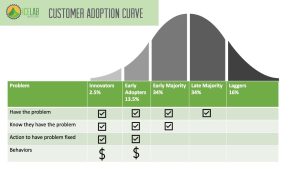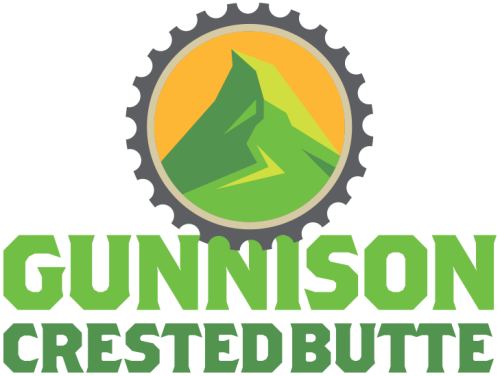Customer adoption for outdoor products
Customer adoption is a fundamental part of any startup business. For entrepreneurs, customer adoption is the process of educating customers about what the problem is, how your product is the solution to the problem, and why they should purchase your product. As outdoor enthusiasts, the products we buy tend to be technical and specific. Outdoor gear needs to function properly for us to enjoy our activities safely. This leads to a more complex customer adoption process. It requires founders to actively address their customer adoption challenges before attempting to scale their business. Keep reading to learn how to identify the characteristics of early adopters and then create customer segmentation profiles around these characteristics. Finally, you’ll learn what to do with this information and how it can help build a foundation for creating a wider customer base for your outdoor product.
Who are the early adopters?
The customer adoption curve
Let’s first look at the customer adoption curve below. You may recognize its basic shape if you’ve taken a statistics class. The bell curve accurately represents the consumer bases’ buying habits. With any new product, there are a lot of unknowns in the eye of the consumer. Your job as an entrepreneur is not to convince everyone that your product is the best. Rather, your primary job is to identify people most likely to understand your value proposition, learn their behaviors and buying habits and then retarget similar people based on these results. These consumers are known as innovators and early adopters. Looking back at the adoption curve, we can see that these segments only make up a small portion of the overall consumer market. This means a small business’s efforts must always be as efficient as possible. As we can see, the innovators and early adopters check all of the boxes necessary for your value proposition to resonate with them.

Traits of early adopters
- They have the problem.
- We like to think of entrepreneurs as problem-solvers. You have created a product or service to address pain points in people’s lives. These consumers experience the problem you’re solving on a regular basis.
- They know they have the problem.
- All consumers have pain points in their lives. Their awareness of these problems begins to set innovators and early adopters apart. They are acutely affected by these problems enough that it becomes top of mind.
- They are willing to take some action to solve their problem.
- Ultimately, these consumers are willing to pay or take some other action to have these problems solved. This is where your value proposition is the strongest and where you will be most effective in conveying your solution.
How to find early adopters
The last trait is more of a question. What behaviors do these specific people have in common that can be used as tools to reach them? Do they frequent specific stores? Where do they live? How old are they? How do they consume entertainment or news? For outdoor products, you might have even more questions. What sports do these people participate in? Are they casual or avid participants? What other outdoor equipment do they already own? Where do they recreate? With whom do they recreate? How much disposable income do they have to spend on buying outdoor gear?
How to expand customer base over time
Identifying this demographic data is how you save time, energy and money, especially as a startup entrepreneur with limited resources and capital. The customer adoption curve continues to expand as more trust is built in your brand and product or service. Your future goal should be to appeal to the entire consumer base. This takes time and trust. If you fail to appeal to the innovators and early adopters right off the bat, then you will fail to reach the easiest consumers who will validate your solution and build trust in the other consumer groups.
Customer Segmentation
Give them a name and get to know them personally
After you have identified the types of people who are early adopters of your product or service, you’ll want to build out customer segments. Customer segments are a way of categorizing similar people into easily identifiable groups. Essentially, you are creating avatar-like profiles that you can build stereotypes around. You will likely only have between one and three consumer segments that fit your early adopter category. The graphic below shows an example of a customer segment.

Why create customer segments?
Creating these individual and detailed customer segments is useful for many reasons. First, they will drive all of your decisions from a marketing and operations perspective. Your customer is always your guiding light, and as an entrepreneur, your number-one goal is to meet their needs. Second, segments are easily understood by employees, investors and contractors. It is important for everyone involved in your startup to know your customers, not just you.
Targeting customer segments with advertising
Knowing your customer segments will help you be more efficient and targeted with your organic and paid marketing campaigns. One example of this, using the above profile of Rachel Doe, would be to write an SEO-optimized blog post about Hiking your First 14er rather than writing about How to Improve your Marathon Time. Rachel is a casual hiker, not an elite runner, so she will identify more with the first blog topic. Another example is setting up social media ads or boosted posts targeted toward people with specific interests. In the case of Rachel Doe, you could set up an ad to target Denver women in their late twenties who are interested in hiking.
Implementation of customer adoption and segmentation exercises
How to find potential customers
After understanding the process of customer adoption from a high level, you still need to go out and find your early adopters. Keep things simple when you’re first starting out. More often than not, all it takes is a friendly conversation. No sales yet? Go out in public and start a few conversations. For outdoor products, this means finding people who participate in the sport or activity for which your product is designed. See who is interested, and gauge the level of attention from different types of people. Slowly you will begin to see a pattern.
Assuming you have refined your product development and have received feedback from your first few customers, reach out again and ask them to recommend three friends who might be interested in purchasing. Again, you are always looking for early adopters and what characteristics they have. Once you have an idea of who your early adopters are, continue to probe them. Ask them personal questions that relate to how you could target them. Try not to push your perspective. Instead, let them talk. Validate, test and learn.

